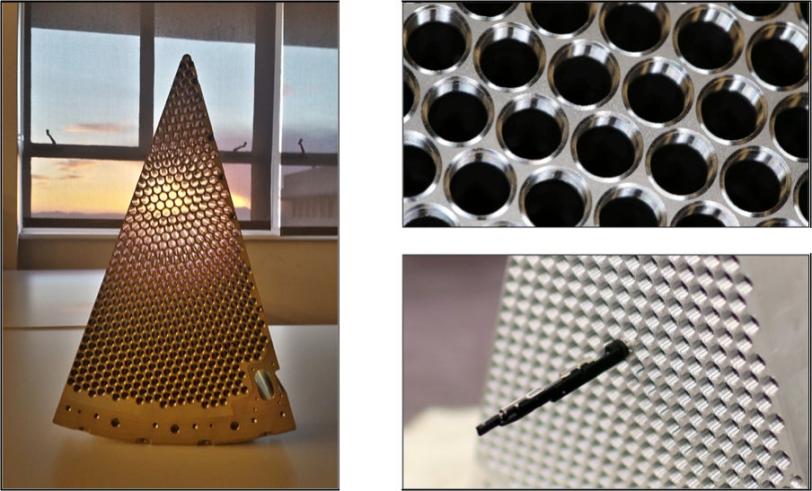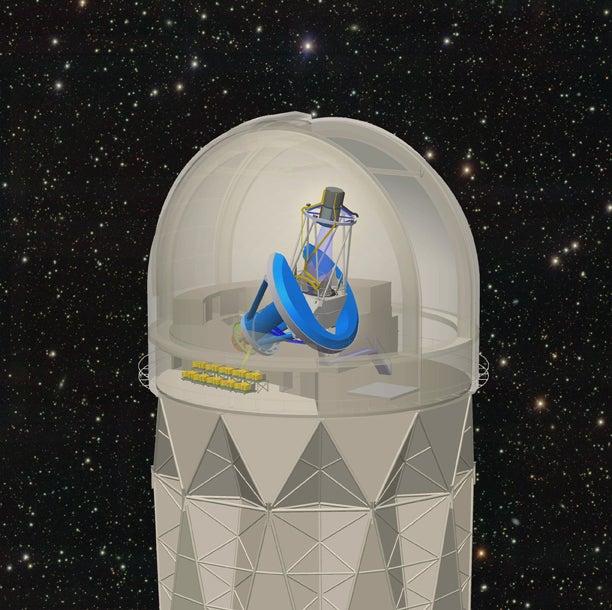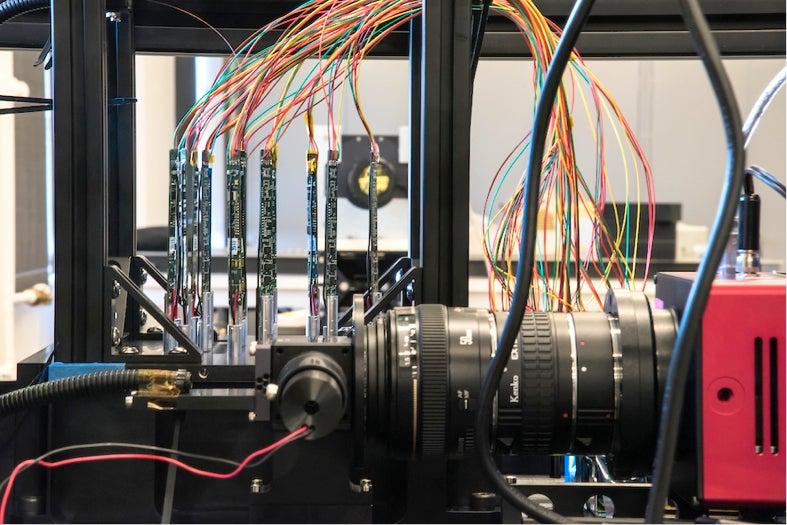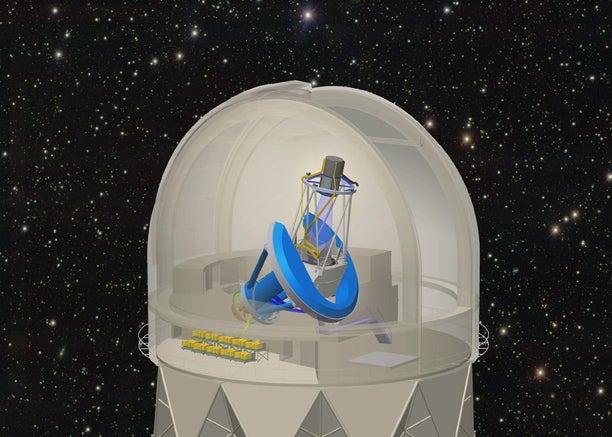DOE Approves Construction of 3-D Galaxy-mapping Project ‘DESI’
Dark Energy Spectroscopic Instrument to Measure Light from 35M Cosmic Objects in Effort to Understand Expansion of the Universe
A 3-D sky-mapping project that will measure the light of 35 million cosmic objects has received formal approval from the Department of Energy to move forward with construction. Installation of the project, called Dark Energy Spectroscopic Instrument (DESI), is set to begin next year at the Mayall 4-meter telescope at Kitt Peak National Observatory near Tucson, Arizona, with observations starting up in January 2019.
Researchers from DOE’s SLAC National Accelerator Laboratory are part of the DESI collaboration, which includes about 300 scientists and engineers from about 45 institutions around the globe.
“We’re very excited – ecstatic – that we’ve gotten to this step,” said DESI Director Michael Levi of Lawrence Berkeley National Laboratory’s Physics Division.
The approval step, known as Critical Decision 3, triggers spending for major components of the project, including the rest of the 5,000 robots that will precisely point the instrument’s fiber-optic cables to gather the light from a chosen set of galaxies, stars and brilliant objects called quasars. The spending will also be used to complete the set of 10 fiber-fed spectrographs that will precisely measure different wavelengths of incoming light.

This light will tell us about the properties of cosmic objects. Since light from objects moving away from us is shifted to redder wavelengths – a phenomenon known as redshift – it will also reveal how quickly the objects are moving away. These details can help us learn more about the nature of dark energy, an unknown form of energy that is driving the accelerating expansion of the universe. DESI’s observations will provide a deep look back in time, up to about 11 billion years ago.
“DESI will be able to make a 3-D map of the universe using an order of magnitude more redshifts than currently exist,” said DESI co-spokesperson Risa Wechsler of the Kavli Institute for Particle Astrophysics and Cosmology (KIPAC). “This will allow us to probe the physics of the universe and discover the true nature of dark energy." KIPAC is a joint institute of Stanford University and SLAC.
Studying Cosmic Expansion History
DESI's robotic array will cycle through separate sets of objects several times each hour during its five-year mission. It will look at one-third of the sky and capture more than 10 times as much data as a predecessor, the Baryon Oscillation Spectroscopic Survey (BOSS).
DESI will provide a more detailed look at the patterned clustering of visible matter in the night sky across a larger range of distances. DESI will also provide a more precise measure of how the universe has spread out over time and help us understand galaxy evolution and dark matter, which is invisible but inferred from its gravitational effects on normal matter.
"The DESI map of galaxies will reveal patterns that result from the interplay of pressure and gravity in the first 400,000 years after the Big Bang," said DESI co-spokesperson Daniel Eisenstein of Harvard University. "We'll be using these subtle fingerprints to study the expansion history of the universe."
Three sky surveys, including the Dark Energy Survey (DES), are now collecting images of the faint galaxies that DESI will target.
“I like to think of the imaging surveys as building the 2-D maps, while DESI adds the third dimension,” said Dustin Lang, a DESI imaging scientist with the University of Toronto. “The crucial third dimension allows us to measure how galaxies cluster together in space over the history of the universe.”

Moving Toward Project Completion
With the latest approval, a pipeline of development efforts will move quickly toward completion.
Six large lenses, each worth $1 million and measuring up to 1.1 meters in diameter, await treatment with an antireflective coating to improve their transparency. The lenses will be housed in a metal frame being constructed at Fermi National Accelerator Laboratory to form a minivan-sized stack known as an optical corrector. This device will be the first piece of equipment installed at the Mayall telescope for DESI in 2018.
To prepare for DESI data analysis, software engineers are using supercomputers at Berkeley Lab’s National Energy Research Scientific Computing Center (NERSC), a DOE Office of Science User Facility, to simulate the data that DESI will gather.
A prototype instrument called ProtoDESI is now installed at the telescope for a two-month run. It uses four small robots to test out the fiber-positioning system and includes cameras and other components to prepare for the full DESI project.
SLAC scientists are involved in various aspects of the project. Kevin Reil and Aaron Roodman are contributing to the system that will guide DESI’s cameras and make sure they are properly focused and aligned. Eli Rykoff is developing software tools to validate data from ongoing imaging surveys that will help select observation targets for DESI. In addition to her leadership of the DESI collaboration, Wechsler is working on computer simulations that will turn DESI’s redshifts into a better picture of cosmic structure and evolution.

A New Generation of Surveys
DESI is one of several planned next-generation observatory projects designed to confront cosmic mysteries, such as dark energy and dark matter. Its data will complement, for instance, information from the future Large Synoptic Survey Telescope (LSST), which will begin in 2022 to take images of billions of objects in never-before-seen detail. SLAC is leading the construction of LSST’s 3.2-gigapixel camera, the largest digital camera ever built for ground-based optical astronomy.
“DESI’s spectroscopic survey will give us different pieces of information than LSST’s imaging survey,” Wechsler said. “By putting the pieces together, we’ll be able to draw a more complete, more accurate picture of what the universe is doing.”
DESI is supported by the DOE Office of Science. Additional support is provided by the National Science Foundation, Division of Astronomical Sciences under contract to the National Optical Astronomy Observatory; the Science and Technology Facilities Council of the United Kingdom; the Gordon and Betty Moore Foundation; the Heising-Simons Foundation; the National Council of Science and Technology of Mexico; the Ministry of Economy and Competitiveness of Spain; and DESI member institutions. The DESI scientists are honored to be permitted to conduct astronomical research on Iolkam Du’ag (Kitt Peak), a mountain with particular significance to the Tohono O’odham Nation.
Editor’s note: This feature is based on a Berkeley Lab press release.
For questions or comments, contact the SLAC Office of Communications at communications@slac.stanford.edu.
SLAC is a multi-program laboratory exploring frontier questions in photon science, astrophysics, particle physics and accelerator research. Located in Menlo Park, Calif., SLAC is operated by Stanford University for the U.S. Department of Energy's Office of Science.
SLAC National Accelerator Laboratory is supported by the Office of Science of the U.S. Department of Energy. The Office of Science is the single largest supporter of basic research in the physical sciences in the United States, and is working to address some of the most pressing challenges of our time. For more information, please visit science.energy.gov.






